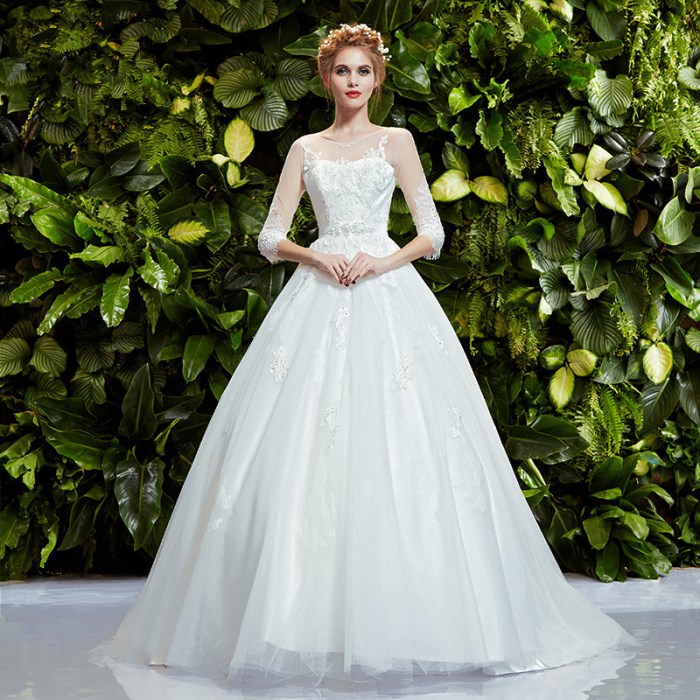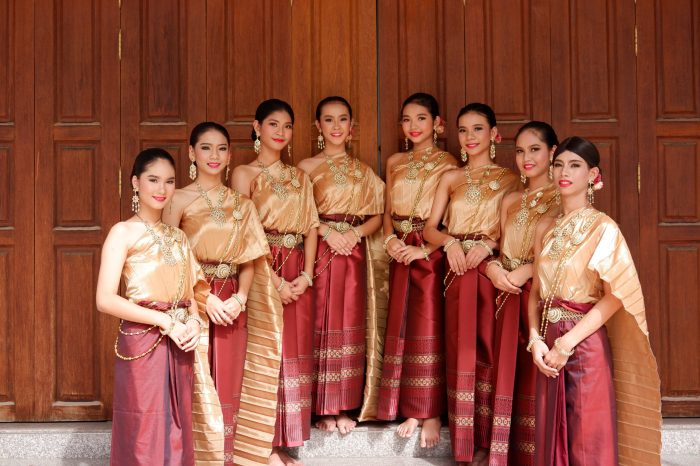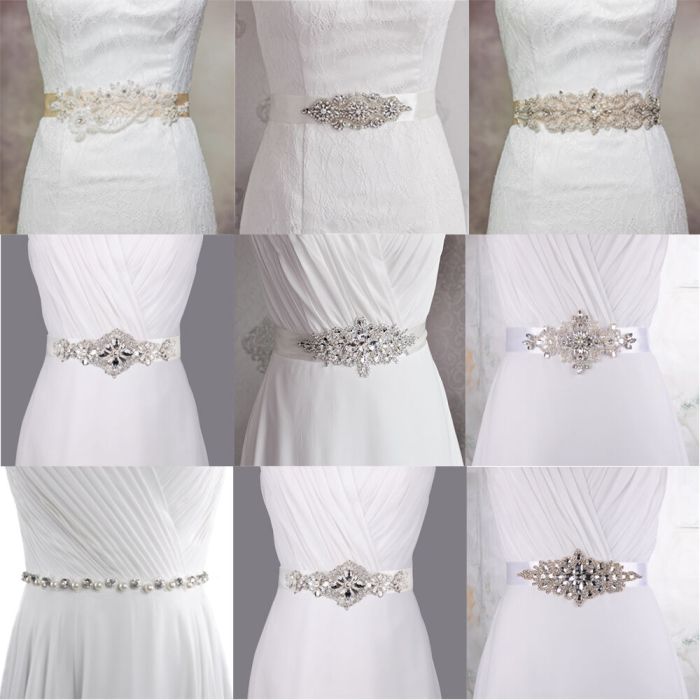Thai Wedding Dress Styles and Custom Tailoring
Wedding dress custom thailand – Thailand boasts a rich tapestry of wedding dress styles, blending traditional aesthetics with modern influences. This exploration delves into the diverse designs, cultural significance, and the process of creating a bespoke Thai wedding gown.
Traditional and Modern Thai Wedding Dress Styles
Thai wedding dresses showcase a fascinating blend of tradition and contemporary design. Traditional styles often incorporate intricate embroidery, vibrant colors, and luxurious fabrics, reflecting the bride’s status and family heritage. Modern interpretations retain elements of traditional design but incorporate sleeker silhouettes, contemporary embellishments, and a wider range of color palettes.
Cultural Significance of Fabrics, Colors, and Embellishments
The choice of fabrics, colors, and embellishments in a Thai wedding dress carries deep cultural significance. For example, silk, a luxurious fabric, often symbolizes prosperity and good fortune. The color red, frequently featured in traditional designs, represents auspiciousness and good luck. Intricate embroidery, often depicting traditional Thai motifs, adds a layer of artistry and cultural identity.
Regional Variations in Wedding Dress Styles
While many elements are common across Thailand, regional variations in wedding dress styles exist. Northern Thai dresses, for instance, may incorporate distinct embroidery patterns and unique fabric choices compared to those in the central or southern regions. These regional differences reflect the diverse cultural heritage of the country.
Thai Wedding Dress Styles: A Comparison
| Style Name | Description | Typical Fabrics | Cultural Significance |
|---|---|---|---|
| Traditional Northern Thai | Elaborate embroidery, long sleeves, often featuring intricate silver or gold detailing. | Silk, brocade | Represents prosperity and family heritage; embroidery patterns often tell stories. |
| Modern Bangkok Style | Sleek silhouette, often incorporating Western elements while retaining traditional Thai details like embroidery or a high neckline. | Silk, chiffon, lace | Blends tradition with contemporary aesthetics, reflecting modern values. |
| Southern Thai Style | Simpler designs, often featuring lighter fabrics and brighter colors. | Cotton, silk | Reflects the warmer climate and more relaxed cultural norms of the region. |
| Royal Thai Style | Highly ornate and elaborate, often incorporating intricate gold embroidery and rich, heavy fabrics. | Heavy silk brocade, velvet | Symbolizes royalty and high social status. |
Custom Tailoring Process in Thailand
Creating a custom Thai wedding dress involves a collaborative process between the bride, designer, and seamstresses. This detailed approach ensures a perfect fit and a garment that truly reflects the bride’s personal style and vision.
Steps in Creating a Custom Wedding Dress
- Initial Consultation: Discussing design preferences, budget, and timeline.
- Design Development: Creating sketches and selecting fabrics and embellishments.
- Pattern Making: Creating a custom pattern based on the bride’s measurements.
- Fabric Cutting and Sewing: Constructing the dress by skilled seamstresses.
- Multiple Fittings: Ensuring a perfect fit and making necessary adjustments.
- Final Touches: Adding embellishments and completing the finishing details.
Roles of Professionals in the Process
The process involves various professionals, including fashion designers, pattern makers, and skilled seamstresses, each contributing their expertise to create the final product.
Materials Used in High-Quality Thai Wedding Dresses
High-quality Thai wedding dresses often utilize luxurious fabrics like Thai silk, imported laces, and fine embellishments such as hand-embroidered details and delicate beadwork. The choice of materials significantly impacts the final cost and the overall quality of the garment.
Design Modifications for Custom Dresses
Custom-made dresses allow for extensive modifications. Brides can incorporate unique details like specific necklines, sleeve styles, train lengths, and personalized embroidery to create a truly one-of-a-kind gown.
Finding and Choosing a Thai Wedding Dress Designer
Selecting the right designer is crucial for a successful custom wedding dress experience. Careful research and consideration of various factors will ensure a positive and fulfilling process.
Key Factors to Consider When Selecting a Designer
- Designer’s Style and Portfolio: Ensure alignment with the bride’s vision.
- Experience and Reputation: Research reviews and testimonials.
- Communication and Collaboration: Assess the designer’s responsiveness and willingness to collaborate.
- Pricing and Payment Terms: Understand the cost structure and payment schedule.
- Location and Accessibility: Consider the convenience of the designer’s studio.
Researching and Evaluating Potential Designers
Thorough research involves browsing online portfolios, reading reviews, and potentially visiting studios to assess the designer’s work and communication style. Comparing the styles of several designers helps refine the bride’s vision and find the best match.
Established Designers vs. Smaller Boutiques
Established designers often have extensive experience and a well-defined style, while smaller boutiques may offer more personalized attention and flexibility. The choice depends on individual preferences and priorities.
Questions to Ask Prospective Designers, Wedding dress custom thailand
- What is your design process?
- What is your experience with creating wedding dresses?
- What fabrics do you typically work with?
- Can you show me examples of your previous work?
- What is your pricing structure?
Cost and Budget Considerations
The cost of a custom Thai wedding dress can vary significantly based on several factors. Careful budgeting and planning are essential to ensure a manageable and enjoyable experience.
Factors Influencing the Cost of a Custom Wedding Dress

Source: emasscraft.org
- Fabric choice and quality.
- Complexity of the design and embellishments.
- Designer’s reputation and experience.
- Number of fittings and alterations required.
- Additional services, such as alterations or accessories.
Typical Expenses Associated with a Custom Gown
Expect costs to include fabric, labor, pattern making, fittings, alterations, and any additional embellishments or accessories. A detailed breakdown should be provided by the designer during the initial consultation.
Strategies for Budgeting and Managing Costs
Setting a realistic budget early on is crucial. Consider prioritizing key elements, exploring alternative fabric options, and discussing payment plans with the designer to manage expenses effectively.
Sample Budget Spreadsheet
| Expense Category | Estimated Cost (THB) |
|---|---|
| Fabric | 50,000 – 150,000 |
| Labor (design & sewing) | 30,000 – 80,000 |
| Embellishments | 10,000 – 50,000 |
| Alterations | 5,000 – 15,000 |
| Total Estimated Cost | 95,000 – 295,000 |
Note: These are estimates and can vary greatly depending on the specific design and chosen materials.
Illustrative Examples of Custom Thai Wedding Dresses
Three distinct custom wedding dresses illustrate the range of styles and aesthetics achievable with bespoke tailoring.
Dress 1: Traditional Elegance
This dress features a classic A-line silhouette crafted from luxurious Thai silk in a rich ivory hue. Intricate gold embroidery, depicting traditional Thai floral motifs, adorns the bodice and flows down the skirt. The design is inspired by classic Thai royal court attire, emphasizing timeless elegance and cultural heritage. The craftsmanship involved meticulous hand-embroidery, ensuring a high level of detail and quality.
Dress 2: Modern Minimalism

Source: thailandinsider.com
This dress showcases a sleek, modern aesthetic with a sheath silhouette crafted from a lightweight silk crepe. The minimalist design focuses on clean lines and a flowing drape, with subtle embellishments such as delicate beading along the neckline. The inspiration comes from contemporary fashion, while the use of high-quality silk maintains a touch of traditional luxury. The craftsmanship highlights the precision of the cut and the seamless drape of the fabric.
Dress 3: Romantic Bohemian
This dress embodies a romantic bohemian style, featuring a flowing A-line silhouette crafted from delicate lace and soft tulle. Delicate floral appliqués adorn the bodice and skirt, creating a whimsical and ethereal effect. The inspiration draws from romantic and nature-inspired aesthetics, incorporating elements of both Western and Thai design sensibilities. The craftsmanship showcases the intricate layering of fabrics and the delicate placement of the appliqués.
Ethical and Sustainable Practices
Increasingly, brides are seeking ethical and sustainable options for their wedding attire. This section explores how to find Thai designers committed to these values.
Importance of Ethical and Sustainable Practices
Choosing ethical and sustainable practices minimizes the environmental impact and ensures fair labor practices throughout the production process. This contributes to a more responsible and conscious approach to fashion.
Eco-Friendly Fabrics and Production Methods
Many Thai designers are embracing eco-friendly fabrics like organic cotton, recycled silk, and sustainably sourced materials. They also adopt production methods that minimize waste and reduce their carbon footprint.
Finding Designers Committed to Ethical Labor Practices
Look for designers who transparently disclose their production processes, emphasizing fair wages, safe working conditions, and ethical sourcing of materials. Online research, word-of-mouth recommendations, and direct communication with designers are valuable tools.
Questions to Ask Designers About Sustainability
- What fabrics do you use, and are they sustainably sourced?
- What are your ethical labor practices?
- What steps do you take to minimize waste during production?
- Do you support local artisans and communities?
- What is your approach to reducing your environmental impact?
Questions Often Asked: Wedding Dress Custom Thailand
What is the average turnaround time for a custom wedding dress in Thailand?
Thailand offers a rich tapestry of custom wedding dress options, reflecting diverse cultural influences. For couples seeking a less traditional approach, incorporating elements of unique casual wedding dresses can create a truly memorable and personalized look. This blend of traditional Thai craftsmanship and modern, relaxed styles results in wedding attire that is both beautiful and uniquely reflective of the couple’s personality.
Ultimately, the choice remains with the couple to design their dream wedding dress in Thailand.
Turnaround times vary depending on the complexity of the design and the designer’s workload, but typically range from 3 to 6 months.
Can I provide my own fabric for my custom wedding dress?
Many designers will accept client-provided fabrics, but it’s essential to discuss this with the designer beforehand to ensure compatibility with their design and construction methods.
What types of payment methods are commonly accepted by Thai wedding dress designers?
Most designers accept cash, bank transfers, and sometimes credit cards. It’s always best to confirm payment options directly with the designer.
How can I ensure the ethical sourcing of materials for my dress?
Ask potential designers about their sourcing practices and look for certifications or statements regarding sustainable and ethical production methods.

